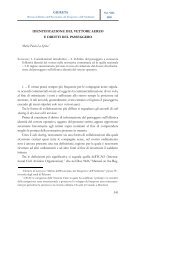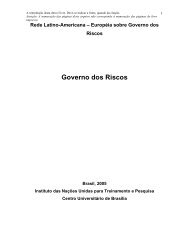Rome II and Tort Conflicts: A Missed Opportunity Abstract Contents
Rome II and Tort Conflicts: A Missed Opportunity Abstract Contents
Rome II and Tort Conflicts: A Missed Opportunity Abstract Contents
Create successful ePaper yourself
Turn your PDF publications into a flip-book with our unique Google optimized e-Paper software.
SYMEON C. SYMEONIDES ROME <strong>II</strong> AND TORT CONFLICTS<br />
192<br />
reasons, pre-tort agreements should either be prohibited or, if permitted, they should<br />
be closely policed.<br />
Regrettably, Article 14 requires only minimal scrutiny. The only restrictions<br />
it imposes on pre-tort agreements (that it does not impose on post-tort agreements) is<br />
that it must be “freely negotiated” <strong>and</strong> that the parties must be “pursuing a commercial<br />
activity.” This is neither sufficient nor free of problems. Even if the term “commercial<br />
activity” was clearly defined or uniformly understood throughout the EU, it would still<br />
include within its scope, relationships that are one-sided, such as those arising from<br />
franchise, licensing, or insurance contracts. For example, a franchise contract is clearly<br />
commercial, yet the franchisee is usually in a very weak bargaining position (which<br />
is why so many states have enacted consumer-protection type statutes to protect<br />
193<br />
franchisees). By allowing pre-tort choice-of-law agreements in these contracts,<br />
Article 14 does not live up to the statement in recital 32 that “[p]rotection should be<br />
194<br />
given to weaker parties by imposing certain conditions on the choice.” As with<br />
some other freedom-laden ideas, Article 14 may well become the vehicle for taking<br />
advantage of weak parties, many of whom are parties to “commercial” relationships.<br />
The argument that the “m<strong>and</strong>atory rules” of paragraphs 2 <strong>and</strong> 3 of Article 14, or the<br />
ordre public exception of Article 26 will protect the weak parties is overly optimistic<br />
because of the high threshold these provisions require before they become operable.<br />
192. See, e.g., EGBGB, art. 42 “After the event giving rise to a non-contractual obligation has<br />
occurred, the parties may choose the law that shall apply to the obligation.”) (emphasis added);<br />
BELGIAN PIL CODE, accord. But see DUTCH PIL ACT, art. 6 (“Where the parties have chosen<br />
the law applicable to any matter relating to tort, . . . that law shall apply between them . . .”). For<br />
the position of American cases law on this issue, see SYMEON C. SYMEONIDES, AMERICAN<br />
PRIVATE INTERNATIONAL LAW _???__ (forthcoming 2008).<br />
193. See SYMEONIDES, AMERICAN PRIVATE INTERNATIONAL LAW, supra note 192 at _???_.<br />
194. ROME <strong>II</strong>, recital (31).<br />
X. CONCLUDING THOUGHTS<br />
Considering its starting point—the Commission’s preliminary draft— <strong>Rome</strong><br />
<strong>II</strong> could have been much worse. Considering the rapporteur’s valiant efforts <strong>and</strong><br />
Parliament’s amendments, <strong>Rome</strong> <strong>II</strong> could also have been much better. The amendments<br />
injected more flexibility, introduced issue-by-issue analysis, <strong>and</strong> differentiated<br />
between issues of conduct regulation <strong>and</strong> loss distribution. Had any of these<br />
amendments survived, they would have considerably improved <strong>Rome</strong> <strong>II</strong>. Unfortunately,<br />
the Council <strong>and</strong> Commission rejected these <strong>and</strong> other amendments. In the end,<br />
<strong>Rome</strong> <strong>II</strong> is what it is. In this author’s view, it is a missed opportunity to do much<br />
better. This view is reinforced by the fact that the European continent, the birthplace<br />
of PIL, has never had a shortage of talent, sophistication, <strong>and</strong> experience in drafting<br />
PIL legislation. Recent national codifications are a solemn testimony of that<br />
56 AMERICAN JOURNAL OF COMPARATIVE LAW (2008) PAGE 44 OF 46



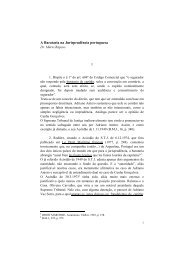

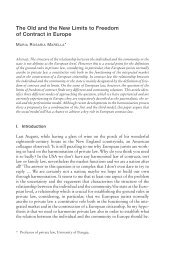


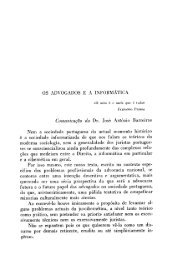
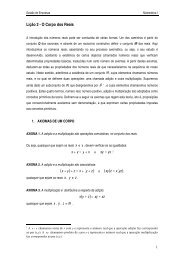

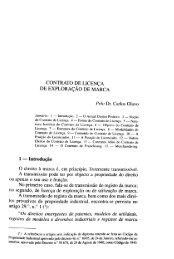
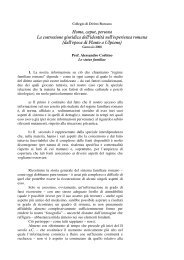
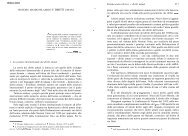

![Luigi Sapio Nozione di islām La parola “islām” [ ] è il mas.dar1 ...](https://img.yumpu.com/15836073/1/185x260/luigi-sapio-nozione-di-islam-la-parola-islam-e-il-masdar1-.jpg?quality=85)
